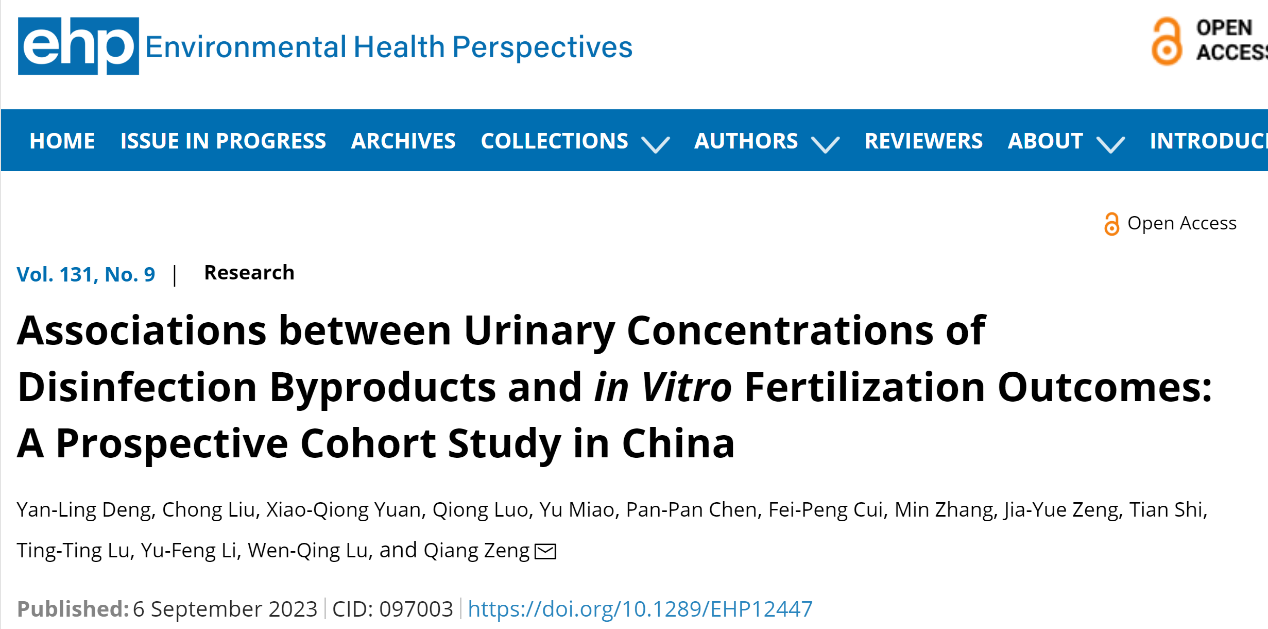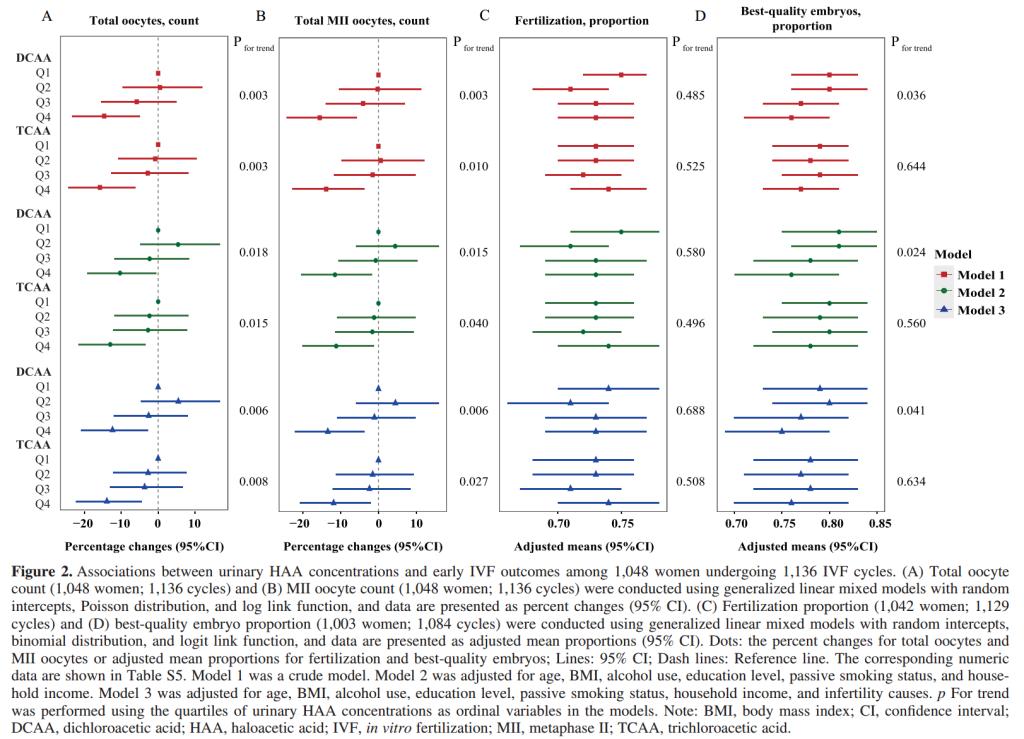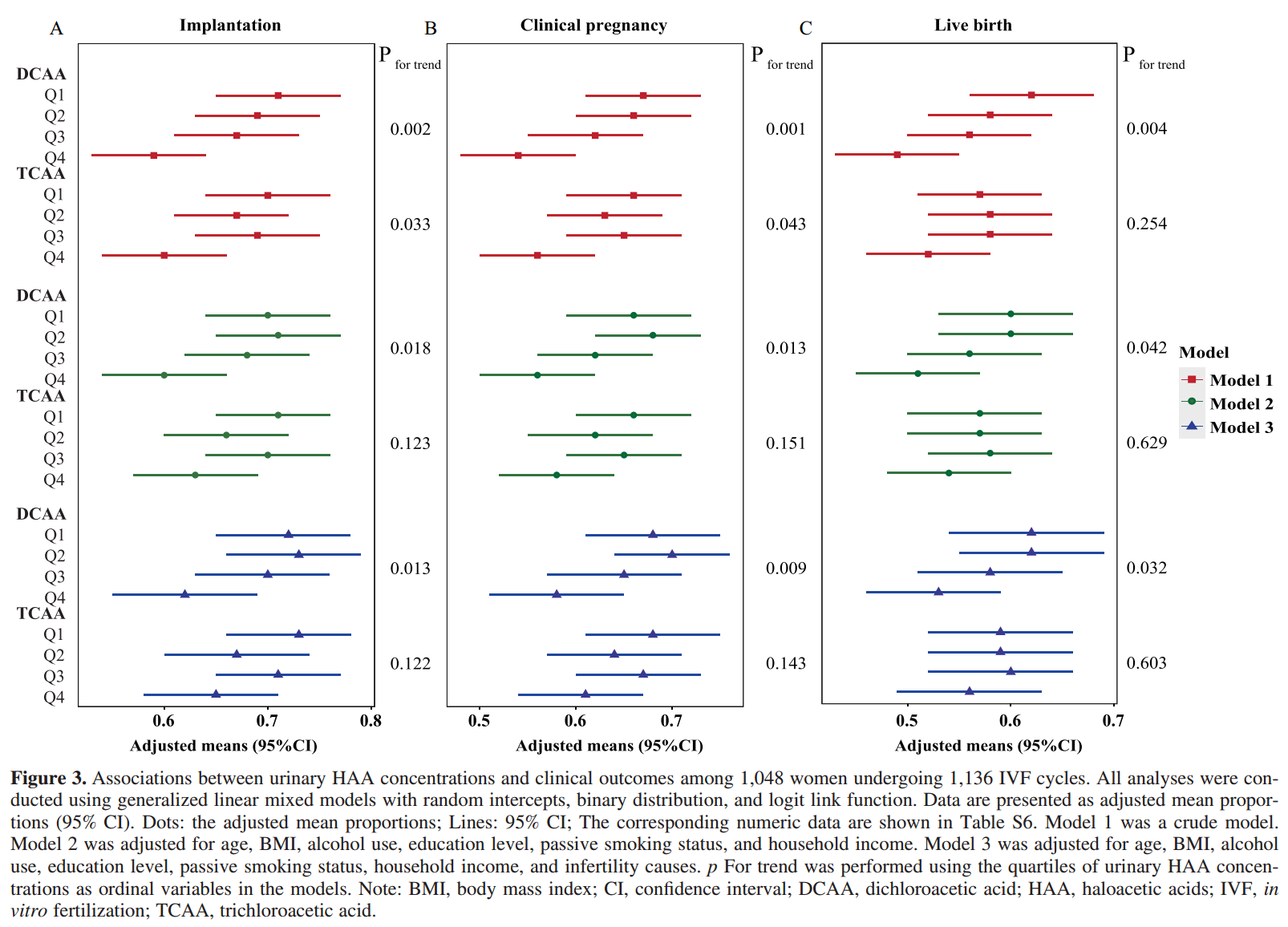On September 6, 2023, an original study entitled "Associations between Urinary Concentrations of Disinfection Byproducts and in Vitro Fertilization Outcomes: A Prospective Cohort Study in China" was published in Environmental Health Perspectives, the top journal with excellent reputation in field of environmental health. This study, led by Prof. Zeng's team at the School of Public Health, Tongji Medical College, Huazhong University of Science and Technology, is the first one to assess the effects of exposure to drinking water DBPs on in vitro fertilization (IVF) outcomes. Based on the ongoing Tongji Reproductive and Environmental study (TREE) cohort, this study showed that exposure to drinking water disinfection byproducts (DBPs) was associated with reduced numbers of total oocytes and metaphase II (MII) oocytes, lower proportion of best-quality embryo, as well as decreased proportions of successful implantation, clinical pregnancy, and live birth among women undergoing assisted reproductive technology (ART) treatment. The findings suggest that drinking water DBP exposures may have adverse effects on the outcomes of in vitro fertilization-embryo transfer (IVF-ET).

Infertility, which is characterized by the inability to achieve a clinical pregnancy after one year of unprotected and regular sexual intercourse, affects 8%-12% of reproductive-aged couples worldwide. In China, it is estimated that 15%-20% of reproductive-aged coupleswomen are suffering from infertility. Since the first baby was born in 1978 by use of IVF, ART has become the most common treatment method for infertility. Although there are approximately 2.8 million ART cycles performed worldwide annually, the success rate of live birth per ART cycle remains around 30%. Therefore, identifying potential risk factors that affect IVF-ET outcomes is critical to improving the quality of pregnancy and safeguarding public health.
Disinfection byproducts (DBPs) are a class of widespread drinking water chemical contaminants formed when disinfectants react with natural and/or synthetic organic matter in source waters. Among more than 700 identified DBPs, haloacetic acids (HAAs) are one of the prevalent species in drinking water. Experimental studies have demonstrated that DBPs including HAAs can alter ovarian steroidogenesis, inhibit antral follicle growth and oocyte maturation, decrease oocyte fertilization capacity, and impair embryo development. However, it remains unclear whether exposure to DBPs in drinking water is associated with early reproductive outcomes, such as oocyte fertilization and embryo implantation.
This study included 1048 women undergoing ART treatment between December 2018 and January 2020 from the TREE study in Wuhan, China. Dichloroacetic acid (DCAA) and trichloroacetic acid (TCAA) concentrations in up to four urine samples were measured as biomarkers of DBP exposures to improve the accuracy of exposure assessment. The IVF outcomes included early IVF outcomes [total oocyte numbers, MII oocyte numbers, the proportions of fertilization and best-quality embryos] and clinical outcomes (implantation, clinical pregnancy, and live birth) were assessed in this hospital and abstracted from its’ electronic medical record. Multivariable generalized linear mixed models, accounting for multiple IVF cycles per woman, were applied to evaluate the associations between urinary biomarkers of DBP exposures and IVF outcomes.
For the IVF outcomes, the crude model and the adjusted models showed that elevated urinary quartiles of DCAA and TCAA concentrations were associated with lower total oocyte numbers and MII oocyte numbers (all P for trends <0.05) (Figure 1). After adjusting for age, BMI, alcohol use, education level, passive smoking status, household income, and infertility causes, compared with those in the first quartiles, women in the fourth quartiles of urinary DCAA and TCAA concentrations had 12.37% (95%CI: -21.01%, -2.80%) and 13.91% (95%CI: -22.37%, -4.53%) lower in total oocyte numbers, as well as 13.14% (95%CI: -22.15%, -3.69%) and 11.87% (95%CI: -20.76%, -1.99%) lower in MII oocyte numbers, respectively. Moreover, women had lower adjusted means (5% decrease, P for trend = 0.041) in the proportion of best-quality embryos comparing the extreme quartiles of urinary DCAA concentrations.
For the clinical outcomes, elevated quartiles of urinary DCAA concentrations were associated with lower proportions of successful implantation, clinical pregnancy, and live birth (all P for trends<0.05) in the crude model and the adjusted models (Figure 2). After adjusting for the same confounders as above, women in the highest quartile of urinary DCAA concentrations had declines in adjusted means for the proportions of successful implantation (14% decrease, P for trend = 0.013), clinical pregnancy (15% decrease, P for trend = 0.009), and live birth (15% decrease, P for trend = 0.032) compared to women in the lowest quartile. These negative associations also persisted when urinary DCAA concentrations were included as continuous variables. There were null associations of urinary TCAA concentrations with proportions of successful implantation, clinical pregnancy, and live birth.

Figure 1. Associations between urinary HAA concentrations and early IVF outcomes among 1048 women undergoing 1136 IVF cycles.
(Source: Environmental Health Perspectives) 
Figure 2. Associations between urinary HAA concentrations and clinical outcomes among 1048 women undergoing 1136 IVF cycles.
(Source: Environmental Health Perspectives)
In this prospective cohort study, the results showed that urinary DCAA and TCAA concentrations were inversely associated with multiple indicators of IVF outcomes, including numbers of total oocytes and MII oocytes, the proportion of best-quality embryos, as well as probabilities of successful implantation, clinical pregnancy, and live birth. These findings provide novel human evidence that preconception exposure to DBPs may have adverse effects on early pregnancy outcomes, which would inform clinical and public regulatory determinations to take precautionary measures to improve the success rates of clinical pregnancy and live birth.
Prof. Zeng is the corresponding author and Dr. Yanling Deng, a postdoctoral fellow at Emory's Rollins School of Public Health currently, is the first author in this work. This study was funded by the National Key Research and Development Plan of China and the National Natural Science Foundation of China. The researchers also sincerely thank the supports from Prof. Yufeng Li's team at Reproductive Medicine Center, Tongji Hospital, Tongji Medical College, Huazhong University of Science and Technology.
Link to original article:https://ehp.niehs.nih.gov/doi/10.1289/EHP12447

